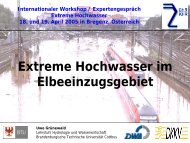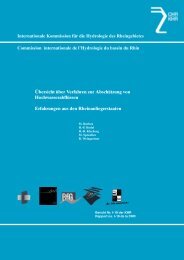ABSTRACTS 'Extreme Discharges' - CHR-KHR
ABSTRACTS 'Extreme Discharges' - CHR-KHR
ABSTRACTS 'Extreme Discharges' - CHR-KHR
You also want an ePaper? Increase the reach of your titles
YUMPU automatically turns print PDFs into web optimized ePapers that Google loves.
evising land use regulations, adopting permanent and temporary structural measures, modifying the management<br />
of values, and taking appropriate action in the event of an impending flood.<br />
The flood risk can be minimised by suitable measures designed to prevent floods, flooding, and losses. Nevertheless,<br />
there will always be a residual risk; and that is where insurance comes in. Insurance makes the uncertainty<br />
of future financial strains calculable. In return for a premium, the policyholder can either buy complete<br />
freedom from that uncertainty or (by paying a lower premium) limit the loss to a certain deductible.<br />
In the discussion of flood control measures, the different types of flood are usually all lumped together. No distinction<br />
is made between relatively common floods (e.g. with a return period of five to ten years), major floods<br />
(e.g. 100-year events), and catastrophic floods, which only occur on average every few centuries. This approach<br />
is a fundamentally wrong and results in conflicting stances and solutions. A distinction must be made between<br />
frequent and very rare floods and between small and large catchments, because the measures called for in each<br />
case are quite different. Table 2 lists the most important measures for each group of events roughly in the order<br />
of their significance and efficacy. Of course, all other measures have to be incorporated as well, but the fact is<br />
that they are not always equally effective.<br />
Table 2: Measures designed for flood control and flood prevention, in the order of their effectiveness and importance<br />
Frequent floods<br />
Return periods below approximately 20 years<br />
"Natural" or "soft" measures<br />
Rare floods<br />
Return periods between 20 and 100 years<br />
Technological measures<br />
Very rare floods<br />
Return periods (far) exceeding 100 years<br />
Organisational measures<br />
- Improved infiltration, removal of<br />
impervious surfaces<br />
- Decentralised retention<br />
- River restoration<br />
- Dyke relocation, widening of river<br />
cross sections<br />
- Simple dykes<br />
- Retaining basins, retention areas<br />
- Engineered dykes<br />
- Polders<br />
- Dyke relocation, widening of river<br />
cross sections<br />
- Flood management<br />
- Flood response<br />
- Emergency relief<br />
- Financial provisions (insurance)<br />
Catastrophes are not only products of chance but also the outcome of interaction between political, financial,<br />
social, technical, and natural circumstances. Risk can never be eliminated completely, it can only be reduced.<br />
The decisive point is the awareness that nature can always come up with events against which no<br />
human means can prevail<br />
Author:<br />
Dr.-Ing. Wolfgang Kron<br />
Head of Hydrological Risks<br />
Geo Risks Research/Environmental Management<br />
Munich Reinsurance Company<br />
Königinstrasse 107<br />
80791 Munich<br />
Tel.: (089) 3891 5260<br />
Fax: (089) 3891 5696<br />
e-mail: wkron@munichre.com<br />
59





